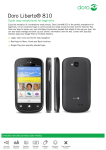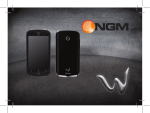Download Untitled
Transcript
Guida rapida - Italiano...................5 Quick Guide - English...................17 Kurzanleitung - Deutsch..............29 Guía rápida - Español...................41 4 Guida rapida - Italiano 5 Assemblaggio Inserire la scheda di memoria Inserire le USIM card Per sfruttare tutte le funzioni di NGM ATLANTIS, si consiglia l'utilizzo di una micro-SD: la scheda va collocata nella parte posteriore del telefono dopo aver rimosso la cover posteriore e la batteria; il suo slot si trova a fianco degli slot USIM. Inserite la scheda micro-SD nello slot, come in figura, con i contatti dorati rivolti verso il basso. Le USIM card contengono i vostri numeri telefonici, i codici PIN, i collegamenti ai servizi esterni, contatti e altri importanti dettagli. Per accedere al vano contenente gli slot delle USIM, spegnere il telefono e sollevare la cover a partire dalla apposita fessura di rimozione cover sul lato destro inferiore del telefono. Rimuovere la batteria ed inserire le schede USIM nei rispettivi slot come mostrato nello schema sottostante. Lo slot USIM1 (superiore) supporta USIM WCDMA. MicroSD Slot superiore: USIM1 (UMTS o GSM) Slot inferiore: USIM2 (GSM) 6 Inserire la batteria Caricare la batteria Il vostro apparecchio è fornito con una batteria a ioni di litio ed è progettato per l’uso esclusivo di batterie e accessori originali NGM. La batteria va collocata nella parte posteriore del telefono. Inserite la batteria nel vano batteria con i contatti rivolti verso l’alto, in corrispondenza di quelli del telefono. Successivamente, ripristinate la cover posteriore del telefono, come mostrato qui di seguito. Caricate la batteria prima di iniziare ad utilizzare l’apparecchio. Utilizzate il cavo USB in dotazione ed il connettore USB posto sul lato destro del telefono. Connettete il caricatore ad una presa della rete elettrica e quindi il dispositivo al cavo USB. Si può caricare il telefono anche collegandolo con il PC, ma in questo caso la carica sarà più lenta. Quando la batteria è in carica, un’icona animata sullo schermo mostra lo stato di avanzamento del processo se il telefono è acceso. Una volta che l’icona della batteria è riempita, la carica è completata e il telefono può essere disconnesso dalla rete elettrica. Attenzione: Non collegate il telefono ad un computer che si sta accendendo o spegnendo per evitare sbalzi di tensione. Per preservare la corretta funzionalità del prodotto e l'integrità della garanzia si raccomanda l'utilizzo di caricabatterie originali NGM. Procedete alla ricarica esclusivamente al coperto e in luoghi asciutti. Un leggero riscaldamento del telefono durante il processo di ricarica è del tutto normale. La batteria raggiungerà la sua piena efficienza funzionale solo dopo alcuni cicli completi di ricarica. 7 On/off e standby Sensori di prossimità e luminosità Ricevitore Flash Fotocamera frontale Fotocamera Touch screen capacitivo Volume “ +” e “–“ Connettore Micro USB Indietro c Speaker Home Ricerca Menu contestuale 8 Ingresso auricolare Microfono Fessura per rimozione cover Microfono secondario Accensione, spegnimento e standby Per accendere il dispositivo, tenete premuto il tasto di accensione. Per spegnere il dispositivo, tenete premuto lo stesso tasto e confermate lo spegnimento selezionando “Spegni”. Una pressione breve permette invece di passare rapidamente alla modalità di standby (schermo spento) o di tornare da questa allo schermo di sblocco (vedi sotto). Per sbloccare il telefono trascinare l’icona lucchetto verso il basso. Per l’accesso diretto ai menu Messaggi / Chiamata / Fotocamera trascinare il lucchetto sopra alle relative icone. Lo schermo principale Intensità segnale USIM Livello batteria Pannello di notifica Indicatore pagine dello schermo principale Menu di chiamata Browser Contatti Menu principale Messaggi La schermata principale è il punto di partenza per l'utilizzo di tutte le applicazioni del telefono cellulare. Altre pagine si trovano affiancate rispetto a quella principale. A queste si può accedere scorrendo lo schermo verso destra o sinistra. Tali pagine sono personalizzabili con i collegamenti delle applicazioni preferite; per collocare un collegamento sulle pagine è necessario passare al Menu principale e selezionare la barra Widget . Per eliminare tali collegamenti, tenere premute 9 le varie icone e trascinarle nel cestino, che comparirà in alto sullo schermo. Il menu principale tornare alla schermata precedente; premere il tasto Home per tornare alla schermata principale. Gestire le due USIM Pannello notifiche Indicatore pagine menu Menu principale, selezionare Impostazioni > Wireless e Reti “Gestione SIM”. Selezionare i nomi degli operatori telefonici corrispondenti a “USIM1” e “USIM2” per attivare o disattivare selettivamente le USIM in qualsiasi momento. Da questo menu è anche possibile personalizzare il colore da attribuire all’icona di ciascuna USIM e decidere quale USIM usare come principale per chiamate, videochiamate, messaggi e connessione dati. Gestire una chiamata Scorrimento menu Controllate il touch screen toccandolo, tenendo premuto o trascinando un dito sullo schermo. Selezionate un’applicazione dal menu principale o scorrete verso destra/sinistra per visualizzare altre applicazioni. Premete il tasto indietro per 10 Chiamate vocali Dalla schermata principale, toccare l’icona del menu di chiamata e digitare il numero usando la tastiera virtuale. Avviare la chiamata premendo l’icona con la cornetta corrispondente alla USIM desiderata. Per terminare, toccare l’icona di fine chiamata. Per rispondere ad una chiamata, trascinare la cornetta verso destra; per rifiutarla, trascinarla verso sinistra, e per rifiutare tramite messaggio portare la cornetta verso l’alto. Per silenziare una chiamata in arrivo, toccare il tasto Volume “+” o “–“ (sul lato sinistro del telefono). Richiamare un numero dal registro chiamate Dal menu principale, selezionare il menu Telefono e toccare l’icona per accedere rapidamente al Registro chiamate effettuate, ricevute e perse o Tutti. Toccare il numero desiderato per avviare la chiamata. Gestire contatti Impostare le suonerie Aggiungere un nuovo contatto Selezionare una suoneria Dal menu principale, selezionare Contatti. Premere l’icona contrassegnata dal simbolo “+”. Scegliere la locazione dove si intende salvare il nuovo contatto (telefono, USIM1 o USIM2). Inserire Nome, Numero ed eventuali altri dettagli del contatto (se il contatto viene salvato sulle USIM non è garantito il salvataggio di eventuali ulteriori dettagli oltre a nome e numero telefonico). Confermare il salvataggio. Aggiungere un nuovo contatto dal registro chiamate Dal menu Telefono, selezionare . Premere sull’icona a sinistra (contraddistinta da un triangolo) del numero che si intende salvare tra le chiamate perse, effettuate o ricevute. Scegliere Aggiungi a contatti e confermare se si vuole aggiungere il numero ad un contatto esistente o crearne uno nuovo. Dopo aver aggiunto nome ed eventuali altre informazioni, confermare con Salva. Dal menu principale, selezionare Impostazioni > Profili audio > Generale. Selezionare Tono di chiamata voce. Scegliere la suoneria desiderata dall’elenco. Se si desidera impostare una suoneria personalizzata, da Musica selezionare il brano audio desiderato, quindi Usa come suoneria premendo il menu contestuale. A questo punto il file audio sarà inserito nell’elenco delle suonerie disponibili. Note: è possibile utilizzare come suonerie file nei formati *mid,*wav o *mp3. Blocco schermo e collegamenti Dal menu principale, selezionare Impostazioni > Personale “Protezione” > Blocco schermo. Selezionare la modalità desiderata per sbloccare lo schermo (Nessuna, Slide, Face unlock, Sequenza, PIN oppure Password) e confermare. Per bloccare rapidamente lo schermo, premere brevemente sul tasto di on/off del telefono. Per sbloccare lo schermo, seguire le indicazioni sullo schermo. Attivare o disattivare rapidamente la vibrazione Per disattivare velocemente la suoneria per le chiamate e i messaggi è possibile tenere premuto il tasto volume “–“ dalla schermata principale. Una volta raggiunto il volume minimo, il telefono entrerà in modalità vibrazione. 11 Inviare e leggere messaggi Inviare SMS e MMS Dalla pagina o dal menu principale, scegliere Messaggi e quindi l’icona corrispondente a Scrivi nuovo messaggio per accedere alla schermata di inserimento testo. Digitare le prime lettere di un nome nel campo destinatario per ricercare un contatto e selezionare il contatto dall’elenco pop-up, oppure inserire direttamente il numero del destinatario. Inserire il testo nell’apposito spazio con la tastiera virtuale. Selezionare l’icona Allega per includere eventuali allegati multimediali (il messaggio sarà convertito in MMS). Premere l’icona Invio e selezionare la USIM card desiderata se non precedentemente selezionata come predefinita dal menu principale in Impostazioni > Wireless e reti “Gestione Sim”. Connettività Il sistema operativo richiede una connessione dati attiva. Se non previsto in abbonamento, il traffico dati implica dei costi; si consiglia quindi di configurare l’accesso Internet tramite WiFi. Per abilitare il traffico dati sulla USIM, andare in Impostazioni > Gestione SIM > Connessione Dati. Connettersi a Internet con la funzione Wi-Fi Potete collegarvi alla rete wireless utilizzando la funzione Wi-Fi. Per attivarla, dal menu principale scegliere Impostazioni > WiFi. 12 Attenetevi a tutte le avvertenze e le indicazioni specificate dal personale autorizzato quando vi trovate in aree in cui l’uso dei dispositivi wireless è limitato, come sugli aeroplani e negli ospedali. Passate alla Modalità offline quando dovete utilizzare solo i servizi che non richiedono l’accesso alla rete. Connettersi a un dispositivo Bluetooth Accendere il dispositivo Bluetooth al quale si desidera collegarsi. Riferirsi alla documentazione del dispositivo. Dal menu principale, scegliere Impostazioni > Bluetooth per attivare il Bluetooth. Scegliere Cerca dispositivi per avviare automaticamente la ricerca di dispositivi Bluetooth. Tra i dispositivi rilevati, selezionare il nome del dispositivo da associare. Il telefono tenterà di associarsi al dispositivo, eventualmente verrà richiesto un codice di associazione. Navigare nel web Connettersi a Internet Dal menu principale, scegliere Browser. Digitare l’URL nella barra degli indirizzi per avviare la navigazione. Se si sceglie di navigare con la connessione dati della rete telefonica, informarsi sui costi o scegliere un contratto dati “flat” con il proprio operatore. In alternativa, utilizzare la connessione Wi-Fi (vedi paragrafo “Connettività”). Email Configurare un account nell’applicazione Email nel Menu principale, seguendo le indicazioni. Geolocalizzazione GPS Il Global Positioning System (GPS) è un sistema di posizionamento su base satellitare, a copertura globale e continua. Per accedere alla funzione GPS, selezionare Impostazioni > Personale “Servizi posizione” > Satelliti GPS. All’interno dello stesso menu potete anche attivare wireless Servizio localizzazione, per appoggiarvi alle reti Wi-Fi quando la connessione è attiva. Quando la funzione GPS viene attivata, il telefono inizia a raccogliere dati dai satelliti disponibili e quindi stabilisce la sua posizione corrente. Per limitare il consumo di risorse (batteria e memoria) si raccomanda di disattivare questa funzione quando non strettamente necessario. Il telefono dispone del sistema di navigazione NGM NAVIGATION SYSTEM© preinstallato, accessibile tramite il tasto multifunzione (lato sinistro). Per ulteriori dettagli sul funzionamento del sistema visitare il sito www.ngm.eu. Scelte rapide Pannello di notifica Per aprire il pannello di notifica, toccate l'area delle icone nella parte alta dello schermo e trascinate il dito in basso. Per nascondere il pannello, trascinate in alto la parte inferiore dell'elenco oppure toccare il tasto indietro. Quando vi trovate all’interno dei menu principali del telefono, dal pannello di notifica è possibile accedere ad un elenco di notifiche provenienti dalle USIM o dal sistema e, nella parte alta, ai 5 widgets di gestione. Questi ultimi sono in sequenza: Wi-Fi, Bluetooth, GPS, Connessione dati e Modalità aereo. Accesso rapido alle applicazioni recenti Quando vi trovate all’interno di una qualsiasi applicazione, mantenete premuto il tasto Home per qualche secondo: verrà visualizzato l’elenco delle applicazioni a cui avete effettuato l'accesso di recente; le medesime saranno selezionabili direttamente a partire dalle icone visualizzate. È anche possibile terminare da qui ciascun processo, semplicemente trascinando l’icona corrispondente verso destra/sinistra. Menu contestuale Quando vi trovate all’interno di una qualsiasi applicazione, premete il tasto Menu contestuale per visualizzare un menu contestuale riferito all’applicazione stessa con le relative funzioni. Inserire testo con SwiftKey Il metodo di inserimento impostato per default nel telefono è quello della tastiera SwiftKey. Il metodo di scrittura SwiftKey è un sistema avanzato per l'inserimento predittivo di testo; quando si scrivono messaggi SMS, MMS o E-mail, tale modalità prevede la parola che si sta digitando, cambiandola ad ogni pressione dei tasti. Durante il primo utilizzo, il programma suggerirà con dei pop-up le innovazioni e le peculiarità di questo sistema di scrittura. SwiftKey ha un Dizionario “intelligente” che trae vocaboli anche dalle varie applicazioni del telefono, quali la rubrica, i social network, ecc. Per il corretto funzionamento del dizionario, è necessario installare nel telefono una micro-SD. Per cambiare i parametri di inserimento del testo, selezionare Impostazioni > Lingua e input > SwiftKey for NGM-Mobile. 13 Avvertenza: il produttore non assume alcuna responsabilità per qualsiasi inadempienza delle linee di condotta sopra stabilite o per ogni uso improprio del telefono cellulare. Il produttore si riserva il diritto di modificare senza preavviso le informazioni contenute in questa guida. Il contenuto di questo manuale potrebbe differire dal contenuto effettivamente mostrato nel telefono cellulare. In tale caso, il secondo prevale. Certificazioni Dichiarazione di conformità (R&TTE) Noi, NGM Italia Dichiariamo sotto la nostra esclusiva responsabilità che il prodotto: Cellulare GSM/WCDMA/Wi-Fi: NGM ATLANTIS a cui si riferisce il presente documento, è conforme alle seguenti norme e/o ad altri documenti normativi. Salute Sicurezza EMC Radio EN 50360, EN 62209-1 EN 60950-1+A11 EN 301 489-1/-7/-17 EN 301 511 EN 300 328 Si dichiara con il presente documento che tutte le serie di test radio essenziali sono state eseguite e che il summenzionato prodotto è conforme a tutti i requisiti essenziali della Direttiva 1999/5/EC. La procedura di dichiarazione di conformità a cui si fa riferimento nell’Articolo 10 e dettagliata nell’Appendice [IV] 14 della Direttiva 1999/5/EC è stata seguita con l’apporto dei seguenti Enti notificati: PHOENIX TESTLAB GmbH Königswinkel 10, D-32825 Blomberg, Germany Documentazione tecnica conservata presso NGM Italia S.r.l. Disponibile su richiesta. (Rappresentante nell’UE) NGM Italia S.r.l. Via L. Da Vinci, 7 – Ponticelli 56020 Santa Maria a Monte (Pi) S.A.R. (Specific Absorption Rate) Informazioni sulla certificazione SAR (Specific Absorption Rate, tasso specifico di assorbimento) I telefoni cellulari sono dei ricetrasmettitori radio. Sono progettati per non superare i limiti di esposizione alle onde radio raccomandati dalle linee guida internazionali. Queste linee guida sono state sviluppate da organizzazioni scientifiche internazionali indipendenti ICNIRP ed IEEE ed includono margini di sicurezza per assicurare protezione alle persone, indipendentemente dalla loro età e salute. Il dispositivo in oggetto è conforme agli standard dell’Unione Europea (UE) che limitano l’esposizione delle persone alla radiofrequenze emesse da dispositivi di telecomunicazione e radio. Questi standard impediscono la vendita di dispositivi mobili che eccedono un livello di tasso specifico di assorbimento (denominato anche SAR) pari a 2,0 watt per chilogrammo di tessuto corporeo. Durante il test, il livello SAR più elevato registrato è stato pari a 0,426 watt per chilogrammo [1,2]. Durante l’uso normale, il livello SAR effettivo potrebbe risultare molto inferiore, poiché il dispositivo è stato progettato per emettere solo l’energia a radiofrequenza necessaria che serve per trasmettere il segnale alla stazione base più vicina. Attraverso la gestione automatica della trasmissione a livelli di potenza inferiori laddove è possibile, il dispositivo riduce l’esposizione complessiva all’energia a radiofrequenza dei soggetti. La dichiarazione di conformità presente sul taglio in questione, dimostra la conformità di questo dispositivo alla direttiva R&TTE (European Radio & Terminal Telecommunications Equipment). [1] I controlli sono stati effettuati in conformità alle direttive internazionali sui controlli. [2] Per l’utilizzo vicino al corpo, questo modello di telefono è stato controllato ed è risultato conforme alle direttive per l’esposizione alle onde elettromagnetiche utilizzando accessori forniti o approvati da NGM e progettati per questo prodotto, oppure utilizzando accessori non contenenti parti metalliche e che posizionano l’unità portatile ad un minimo di 1,5 cm dal corpo. Avvertenze L’OMS (Organizzazione Mondiale della Sanità, o WHO – World Health Organization) conferma che le attuali informazioni scientifiche non indicano la necessità di precauzioni particolari per l’uso dei telefoni cellulari. Tuttavia, per tutti gli utilizzatori non adeguatamente confortati da queste risultanze, NGM consiglia di limitare la propria esposizione o quella dei loro figli, ad esempio riducendo la durata delle chiamate, o utilizzando auricolari e dispositivi “viva voce” per tenere il telefono cellulare lontano dal corpo e dalla testa. Per ulteriori informazioni su questo argomento, NGM invita a consultare il documento dell’OMS (Promemoria n.193, campi elettromagnetici e salute pubblica, I telefoni mobili e le loro stazioni radio base) disponibile al seguente indirizzo: http://www.who.int/peh-emf/publications/facts/fs193_italian_2010.pdf NGM consiglia di usare con moderazione qualsiasi dispositivo mobile di qualsiasi marca e modello ed, eventualmente, tenerlo ad una distanza minima dal corpo di 1,5 cm oppure usare auricolari o dispositivi vivavoce. Copyright © 2012 NGM Italia Nessuna parte di questo manuale può essere riprodotta, distribuita, tradotta trasmessa in alcuna forma o tramite alcun mezzo, elettronico o meccanico, compresi fotocopie, registrazione o salvataggio in qualsiasi archivio di informazioni o sistema di recupero, senza previa autorizzazione scritta da parte di NGM Italia. Bluetooth® è un marchio commerciale registrato in tutto il mondo della Bluetooth SIG, Inc. Wi-Fi® e il logo Wi-Fi sono marchi commerciali registrati di Wi-Fi Alliance. 15 16 Quick Guide - English 17 Set up Installing the memory card Installing the USIM cards In order to use all functions of NGM ATLANTIS, it is advisable to install a micro-SD card: it must be inserted in the back side of the phone, after powering it off, removing the back cover and the battery. A dedicated slot fort the memory card is placed right next to USIM slots; slide in the memory card so that the gold contacts are turned downwards. The USIM card stores information as your personal phone number, PIN code, carrier services numbers, contacts and other important details. To access the USIM slots, turn off the phone, take off the back cover by lifting it up from its lower part. The slots for the USIM cards are placed over the battery tray. Insert your USIM cards following the illustration. The upper slot supports WCDMA. MicroSD Upper slot: USIM1 (UMTS or GSM) Lower slot: USIM2 (GSM) 18 Inserting the battery Charging the battery Your device is provided with a lithium-ion battery and is designed to be used exclusively with original NGM batteries and chargers. The battery must be inserted into the backside of the phone (see illustration below) with the battery contacts facing the contacts in the battery tray. When done, put the hind cover back into position as shown in the following illustrations. Please charge the battery completely before starting to use the device. Use the provided USB cable, connecting one end to the provided wall socket adaptor (placed into a socket) and the other end to the USB connector placed on the right side of the phone. The phone can also be charged by connecting it to a PC USB port but in that case it will charge more slowly. While the battery is charging, an animation on screen will show the charging progress if the phone is on. Once charge is completed, the icon will be filled and the phone can be disconnected from the grid. Warning: Do not connect the phone to a booting-up or running down PC to avoid voltage jumps. In order to preserve the correct functioning of the device and in order not to compromise warranty, the sole use of original NGM battery chargers and accessories are recommended. Please charge the battery indoors, in a dry and favorable environment. It’s normal for the battery to get slightly warm during the charging process. The battery will reach its full capacity when cycled several times. 19 Brightness and proximity sensor Earphone plug Receiver On/off and Standby key Camera Volume “ +” and “–“ Capacitive touch screen Micro USB connector Back Home Speaker Browse Contextual menu 20 Microphone Slit for cover removal Flash Secondary microphone Turn on, turn off and standby The main screen Press and hold the on/off key to turn on the phone. Press and hold the same key and confirm your intention to turn off the phone. A quick pressure of the on/off key sets the phone on standby-mode (screen off) or allows you to go back to the standby screen (see below). USIM signal intensity Battery level Notification panel Main screen page indicator bar Drag down the lock in order to unlock the screen. For direct access to the Messaging / Call/ Camera menus, move the lock on the correspondent icons. Phonebook chiamata Call Menu chiamata Main Menu Messaging Browser The main screen is the starting point for the use of all applications of the phone. Other main screen pages are available (as indicated by the white bar), just swipe the screen left or right. These pages can be freely personalized with one’s favorite applications, shortcuts and widgets. Just keep pressed the icon of the wished function in the application menu under the Widgets function and then place the icon on the preferred main screen. To remove the icons, keep them pressed and drag them to the big “X” that appears in the upper part of the screen. 21 The Main Menu Notification panel Menu page indicator Managing the two USIM cards From the main menu, select Settings > SIM Management ( in Wireless & Networks). Select the “USIM1” and/or “USIM2” operator checkboxes to activate/deactivate the USIM cards selectively in any moment. In this menu you can moreover assign custom colors to each USIM card and define the card (or “always ask”) for your voice calls, vido calls or data connections. Managing calls SCROLL Voice calls From the main screen, touch the Call Menu icon in order to open the calling screen. Use the virtual keypad to digit the desired phone number. Select the calling icon of the USIM card that you want to call with. To end the call, press the End key. To answer a call, drag the phone icon to the right; to reject a call, drag the phone icon to the left. To reject a call with a text message, drag the phone icon upwards. To silence an incoming call, briefly press the Volume “+” or “–“ keys on the right side of the device. Call a number from the call history Use the touch screen by touching, pressing, sliding your finger over it. Select an application from the main menu or scroll the main menu pages right and left to find the desired one. Press the back key to get back to the previous screen or press Home to get back into the main screen. 22 From the main screen, select Call Menu and the Call log tab (clock Icon) to access rapidly the last sent, missed and received or all calls. Click onto the calling icon to the right of the number to call it back. Managing contacts Screen lock and shortcuts Add a new contact From the main screen/menu, select the Contacts icon. Select the icon with the “+” on it. Select the storage (Phone, USIM1 or USIM2). Insert Name, Number and eventual other details (if saving on the phone memory). Confirm by selecting Save. From the main menu, select Settings > Personal > Security > Screen lock. Select the desired unlocking mode (None, Slide, Face Unlock, Pattern, PIN or Password) and confirm. In order to quickly lock the screen, briefly press on the power on/off key of the phone. To unlock it, follow the instructions on the screen. Add a new contact from the call history From the main screen, select Call Menu and the Call log Tab (arrows icon). Keep the desired number pressed (among the incoming, outgoing and missed calls) until a popup with various options appears. Select Add to Contacts and choose if you want to create a new one or add the number to an existing contact. Enter the name and eventual other information and confirm by selecting Done. Set ringtones Select a ringtone From the main menu, select Settings > Device > Audio Profiles > General . In Voice call ringtone, select the desired ringtone. If you wish to set a personalized ringtone, from Music you can select a song and by pressing the contextual menu, choose Set as ringtone. After, the song will be available in the list of selectable ringtones. Note: you can use *mid,*wav or *mp3 files as ringtones. Rapid activation of vibration mode Rapidly disable ringtones and message alerts by pressing Volume “-“ until it gets to minimum and then switches to Vibration mode. By pressing “-“ again, you set it Silent. Send and receive messages Send SMS and MMS From the main screen or menu, select Messaging and select the icon with the “+” symbol to access the text input screen for a new message. Write the first few letters of a contact name into the recipients bar and select the desired contact from the popup contact list that will appear, or directly insert the recipient’s number. Write the text into the dedicated space with the virtual keypad. Select the Attach-icon to insert multimedia files (the message will automatically be converted into MMS). Press the Send key and then the USIM that you want to use (unless a Default SIM has been chosen in SIM Management) 23 Connectivity The operation system requires an active data connection. If data traffic is not included in your phone contract, it could imply extra costs. In that case it is advisable to configure the internet access through WiFi. The activation/deactivation of the data traffic on the USIM is in Settings > Wireless and Networks > SIM Management > Data Connection. Connect to the Internet using WLAN Connect to the wireless net using the Wi-Fi function. In order to activate it, from the main menu choose Settings > Wireless and Networks > Wi-Fi on/off. Configure Wi-Fi and manage the access points by selecting Wi-Fi. Please follow all warnings and indications concerning the use of wireless devices in areas where the use of such functions is restricted (airplanes, hospitals, etc.). Switch to Airplane mode when you have to use only the functions that do not need Network access. Connecting to a Bluetooth device Switch on the other Bluetooth™ device. Refer to the documentation of the device. From the main menu, select Settings > Wireless and Networks > Bluetooth on/off to activate Bluetooth. For a rapid activation/deactivation use the dedicated key on the notification panel. Select Bluetooth > Search for devices to find other Bluetooth devices. 24 Among the found devices, select the name of the device that you want to pair. The phone will try to pair the device, eventually asking for a pairing code. Web navigation Connect to the Internet From the main screen or the main menu, select Browser. Write the URL into the address bar to start navigation. If you choose to navigate with the phone network data connection, please make sure to be informed about the costs or choose a “flat” data tariff with your operator. Alternatively, you can use the Wi-Fi connection (see paragraph “Connectivity”). Email Configure an account in the Email application of the Main Menu, following the indications. GPS geolocalization The Global Positioning System (GPS) is a system based on the satellite-related position determination, with global and continuous covering. The function is in Settings > Personal > Location services > GPS satellites. Inside the same menu you can also activate Location service that contributes in the position finding using the available Wireless Networks. When the GPS function is active, the phone begins to collect data from the available satellites and determines the current position. Limit the use of battery and memory by switching off this function when you don’t need it. The phone integrates the NGM NAVIGATION SYSTEM©, that is accessible through the main menu. For more details please visit www.ngm.eu. Rapid access Notification panel Open the notification panel by touching the upper area containing the battery and signal-intensity icons and drag it downwards. To hide the panel, push it up again starting from the bottom. From the panel you have rapid access to a list of notifications from the USIM or the System and to the control panel with 12 management and settings - widgets. To change the text input parameters, select Settings > Personal > Language and input > SwiftKey for NGM-Mobile Rapid access to recent applications When you are inside any application, press and hold the Home Icon: a list of the most recent applications that have been opened will be shown and can be directly selected. Contextual menu Inside any application, press the Contextual Menu Icon to visualize a contextual menu that refers to the application with related functions. SwiftKey text input The default text input method is the SwiftKey keyboard. SwiftKey is an advanced predictive text input system; when writing SMS, MMS or E-mails, this mode predicts the word while you are writing it, changing it at every key pressure. During the first use, the program will suggest with popups the innovations and peculiarities of this writing system. SwiftKey has an “intelligent” Dictionary that retrieves words also from other applications in the phone, such as the phonebook or the social networks etc. For the correct use of this function, the micro-SD contained in the selling package has to be installed into the phone. Warning: NGM Italia will not bear responsibility for any incompliance with the above guidelines or improper use of the mobile phone. The company reserves the right to modify any of the content in this user guide without previous public announcement. The content of this manual may vary from the actual content displayed in the mobile phone. In such case, the latter shall govern. 25 Certifications Declaration of conformity (R&TTE) We, NGM Italia Declare under our sole responsibility that the product identified as GSM/WCDMA/Wi-Fi Mobile Phone: NGM ATLANTIS Conforms to the following standards and specifications: Health Safety EMC Radio EN 50360, EN 62209-1 EN 60950-1+A11 EN 301 489-1/-7/-17 EN 301 511 EN 300 328 We declare that all the series of fundamental radio test have been conducted and that the aforesaid product meets all the essential requirements of the Directive 1999/5/EC. The conformity assessment procedure referred to in Article 10 and detailed in Annex IV of Directive 1999/5/EC has been followed with the involvement of the following notified bodies: PHOENIX TESTLAB GmbH Königswinkel 10, D-32825 Blomberg, Germany All technical documents conserved at NGM Italia S.r.l. Available on request. (UE Authorized Representative) 26 NGM Italia S.r.l. Via L. Da Vinci, 7 – Ponticelli 56020 Santa Maria a Monte (Pi) S.A.R. (Specific Absorption Rate) Information on SAR certifications Cell phones are radio transceivers. They have been projected not to exceed the radio wave exposition limits recommended by international guidelines. These guidelines have been determined by the international independent scientific organizations ICNRP and IEEE and include security limits to ensure protection to all persons, independently from their age and health conditions. This phone meets European Union (EU) requirements concerning exposure to radio waves coming from telecommunication and radio devices. The exposure standard for mobile phones employs a unit of measurement known as SAR (Specific Absorption Rate). The SAR limit recommended by the EU Council is 2.0 W/kg averaged over ten grams of body tissue. The highest SAR value for this model phone when tested for use at the ear was 0,426 watt/kg [1,2]. Although the SAR is determined at the highest certified power level, the actual SAR of the phone while operating can be well below the maximum value. This is because the phone is designed to operate at multiple power levels so as to use only the power required to reach the network. In general, the closer you are to a base station, the lower the power output of the phone. The Declaration of Conformity here above proves that the designated product is in compliance with the essential requirements and other relevant provisions of the R&TTE Directive (European Radio & Terminal Telecommunications Equipment)1999/5/EC [1] These controls have been international guidelines on controls. made according to http://www.who.int/mediacentre/factsheets/fs193/en/index.html NGM advises to use mobile devices of any brand or model with moderation and to keep them at a minimum distance of 1,5cm from the body or to use earpieces or other hands-free devices. [2] For the use next to the body, this telephone model has been controlled and is conform to the directives for the exposition to electromagnetic radiation, when used with accessories provided by or approved by NGM and not containing metallic parts and that position the mobile phone at least at 1,5 cm distance from the body. Warnings WHO (World Health Organization) confirms that the actual scientific information does not indicate the necessity to adapt particular precautions for the use of cell phones. Nevertheless, for all those users not comforted by these data, NGM advises to limit their own and their children’s exposure, for instance by reducing the calling time, or by using earpieces or hands-free devices to keep the mobile phone distant from the body and the head. For more information on the argument, NGM invites to consult the WHO document (Fact sheet N°193, June 2011) entitled Electromagnetic fields and public health: mobile phones at the following web address: Copyright © 2012 NGM Italia No part of this manual may be reproduced, distributed, translated, or transmitted in any form or by any means, electronic or mechanical, including photocopying, recording, or storing in any information storage and retrieval system, without the prior written permission of NGM Italia. Bluetooth® is a registered trademark of the Bluetooth SIG, Inc. worldwide. Wi-Fi® and the Wi-Fi logo are registered trademarks of the Wi-Fi Alliance. 27 28 Kurzanleitung - Deutsch 29 Inbetriebnahme Speicherkarte einfügen Einsetzen der USIM Karten Um alle Funktionen von NGM ATLANTIS zu verwenden, ist es ratsam eine Micro-SD einzusetzen: der Slot für die MicroSD Karte befindet sich neben dem Slot B. Setzen Sie die Micro SD Karte in dem Slot ein so dass die goldene Kontaktfläche nach unten weist. Die USIM Karten enthalten Ihre Telefonnummern, PINNummern, Servicenummern, Kontakte und andere wichtigen Details. Um Akkufach und USIM Slots zuzugehen, schalten Sie bitte zuerst das Telefon aus. Entfernen Sie das hintere Cover indem Sie es von unten aus abheben. Entfernen Sie den Akku und setzen Sie die USIM Karten mit der goldenen Kontaktflächen nach unten weisend in die passenden Slots ein. Der SIM1 Slot unterstützt WCDMA USIM. MicroSD Oberes Slot: USIM1 (UMTS oder GSM) Unteres Slot: USIM2 (GSM) 30 Akku einsetzen Ihr Gerät wird mit einem Lithium Akku geliefert und ist dazu entworfen worden, ausschließlich mit originalen NGM Akkus und Zubehör betrieben zu werden. Der Akku muss in die Rückseite des Telefons eingesetzt werden, richten Sie die goldenen Kontaktflächen des Akkus mit den entsprechenden Kontaktflächen des Akkufaches aus. Wenn Sie fertig sind, setzen Sie das Cover wieder richtig auf die Telefonrückseite auf. Akku aufladen Laden Sie den Akku vollständig auf bevor Sie das Gerät benutzen. Verwenden Sie dazu das mitgelieferte Ladegerät und die USB Buchse auf der oberen Seite des Telefons. Stecken Sie das Ladegerät vorerst in die Steckdose, anschließend verbinden Sie das USB-Kabel zuerst mit dem Ladegerät und dann mit dem Telefon. Der Akku kann auch an einem PC aufgeladen werden, in diesem Fall wird aber der Ladevorgang langsamer sein. Wenn das Telefon eingeschaltet ist, zeigt während der Ladung das Ladesymbol den Status des Vorganges an. Sind alle Balken gefüllt, so ist der Akku geladen und das Telefon kann vom Stromnetz getrennt werden. Achtung: Verbinden Sie das Telefon nicht mit einem ein-oder ausschaltenden PC, um Spannungssprünge zu vermeiden. Um die korrekte Funktion und die Produkt-Garantie zu bewahren verwenden Sie immer originale NGM Ladegeräte. Laden Sie das Gerät immer in trockenen Innenräumen auf. Eine leichte Erwärmung des Gerätes während der Ladung ist normal. Der Akku erreicht seinen vollen Leistungsumfang wenn es einige Male vollständig aufgeladen wurde. 31 Kopfhörer Buchse Ein/aus und Standby Helligkeit und Nähe Sensor Vordere Kamera Hörer Kamera Kapazitives touch screen Lautstärke “ +” und “–“ Mikro USB Buchse Zurück Home Suche Lautsprecher Mikrofon Kontextuelles Menü 32 Schlitz für Coverentfernung Flash Sekundäres Mikrofon Ein- und ausschalten, Standby Der Hauptbildschirm Um das Telefon einzuschalten, drücken Sie einige Sekunden lang die Ein/Aus Taste. Um das Gerät auszuschalten, halten Sie die Ein-Aus Taste nochmals verlängert gedrückt und bestätigen Sie auf dem Touch Screen die Ausschaltung. Ein schneller Druck der Ein/Aus Taste wird das Telefon in Standby stellen und den Bildschirm ausschalten; nochmaliger leichter Druck wird das Standby aufheben (siehe unten). Um das Telefon zu entsperren, schieben Sie das Schloss nach unten. Um direkt ins das Anruf-/ Mitteilungs-/ Kamera- Menü zu gelangen, schieben Sie das Schloss jeweils auf das dedizierte Icon. USIM Signalstärke Akku Ladezustand Hinweistafel Hauptbildschirm Indikator Telefonbuch Anruf Menü Hauptmenü Mitteilungen Browser Der Hauptbildschirm ist der Ausgangspunkt für alle Funktionen im Telefon. Es hat weitere Seiten (siehe Indikatorbarre), die durch das Verschieben vom Bildschirm direkt besichtigt werden können. Diese Bildschirme können mit verschiedenen Shortcuts personalisiert werden, indem die gewünschte Anwendung im Hauptmenü-Bildschirm unter Widgets gedrückt gehalten wird bis sie auf dem Hauptbildschirtm erscheint und beliebig geordnet werden kann. Um sie zu verwerfen, halten Sie sie nochmals verlängert gedrückt und schieben Sie sie auf die große „X“ die oben erscheint. 33 Das Hauptmenü Hinweistafel Menü Seitenindikator SCROLLEN USIM Verwaltung Im Hauptmenü wählen Sie Einstellungen > Drahtlos&Netzwerke > SIM Verwaltung. Um in jedem Moment beliebig die USIM Karten zu aktivieren oder deaktivieren, markieren Sie die Checkbox neben der gewünschten USIM Karte. Wenn Sie die USIM1 und/oder USIM2 Icons direkt wählen, öffnen Sie ein Menü in dem Sie den USIM Karten die Hintergrundfarbe zuteilen können. Weiter können Sie den Sprachanrufen, Videoanrufen und der Datenverbindung jeweils eine USIM zuteilen oder „Immer nachfragen“ wählen. Anrufe verwalten Sprachanrufe Tasten und Icons im Touch Screen können mit dem Finger gedrück, verschoben und gedrückt gehalten werden. Wählen Sie eine Anwendung aus dem Hauptmenü oder browsen Sie es nach oben und unten.Mit der Zurück-Taste gelangen Sie in das vorherige Bildschirm zurück, die Home-Taste bringt Sie in den Hauptbildschirm zurück. 34 Aus dem Hauptbildschirm wählen Sie das Anruf Menü-Icon, somit öffnen Sie das Anruf-Menü mit der Virtuellen Tastatur auf der ersten Kartei. Geben Sie die gewünschte Nummer ein. Drücken Sie das Anruf Icon mit der Nummer der gewünschten SIM Karte, mit der Sie anrufen möchten. Um einen Anruf zu beenden, drücken Sie auf das Ende- Icon. Um einen eingehenden Anruf zu antworten, schieben Sie das Telefon-Icon nach rechts. Um einen Anruf zu verweigern, schieben Sie das Telefon-Icon nach links. Um einen Anruf mit einer Mitteilung zu verweigern, schieben Sie das Telefon-Icon nach oben. Um einen eingehenden Anruf stumm zu stellen, drücken Sie kurz auf eine der Lautstärke-Tasten. Eine Nummer aus den Anrufprotokollen zurückrufen Aus dem Hauptmenü, wählen Sie das Anruf Menü-Icon und die Anrufe-Kartei um die zuletzt eingewählten, empfangenen und verpassten Anrufe aufzulisten. Drücken Sie auf das Telefon Icon rechts von der Nummer um sie direkt anzurufen. Kontakte verwalten Einen neuen Kontakt einspeichern Im Hauptmenü wählen Sie Kontakte. Wählen Sie das Icon mit dem „+“ Symbol. Wählen Sie den Speicherort aus (Telefon oder USIM Karten) Geben Sie Namen und Nummer und eventuelle andere Details ein (wenn Sie auf Telefon speichern). Bestätigen Sie die Speicherung mit Fertig. Neuen Kontakt aus den Anrufprotokollen hinzufügen Im Hauptmenü wählen Sie das Anruf Menü Icon. Wählen Sie in der Anrufe-Kartei die Nummer die Sie speichern wollen (unter den angenommenen, eingewählten und verpassten Anrufen oder Alle). Halten Sie die Nummer verlängert gedrückt, wählen Sie Zu Kontakten hinzufügen und wählen Sie ob Sie die Nummer zu einem bestehenden Kontakt hinzufügen wollen oder ein neuer Kontakt erstellt werden soll. Nachdem Sie Namen und eventuelle andere Infos hinzugefügt haben, bestätigen Sie mit Fertig. Klingeltöne einstellen Klingelton Auswahl Im Hauptmenü wählen Sie Einstellungen > Gerät > Audioprofile. Wählen Sie Allgemein > Sprachanruf - Rufton und wählen Sie den gewünschten Klingelton aus der Liste aus. Wenn Sie einen personalisierten Klingelton möchten, öffnen Sie in Musik ein gewünschtes Stück aus und berühren Sie das Kontextuelle Menü-Icon; anschließend wählen Sie Als Klingelton einstellen. Das Musikstück wird in den Klingeltönen verfügbar sein. Anmerkung: Es können Klingeltöne in den Formaten *mid,*wav und *Mp3 verwendet werden. Displaysperre und Schnelltasten Displaysperre: Aus dem Hauptmenü, wählen Sie Einstellungen > Persönlich > Sicherheit > Bildschirmsperre. Wählen Sie die gewünschte Sperre (Keine - Wischen – Muster – PIN Kennwort). Eine schnelle Aktivierung der Display-Sperre wird durch den schnellen Druck der Ein/Aus Taste auf der Telefonseite erhalten. Um den Bildschirm wieder zu aktivieren, folgen Sie den Anleitungen. Schnelle Aktivierung der Vibration Aus dem Hauptbildschirm aus drücken Sie so lange auf die Lautstärke „-“ Taste (seitlich auf dem Telefon), bis das Telefon auf das Vibrations-Profil gestellt wird. Nochmaliges drücken der „-“ Taste wird das Telefon auf Stumm stellen. 35 Mitteilungen senden und lesen SMS und MMS senden Aus dem Hauptmenü oder Hauptbildschirm heraus wählen Sie Mitteilungen und dann das icon mit dem „+“ Symbol. Wählen Sie direkt die Empfängernummer ein oder berühren Sie das Kontakte-Icon um den Empfänger aus den Kontakten zu wählen. Geben Sie den Text in das dedizierte Rechteck mit der virtuellen Tastatur ein. Wenn Sie eine MMS versenden wollen, wählen Sie das Anhängen-Icon und fügen Sie Multimedia Dateien ein. Wählen Sie das 1 oder 2 Sende-Icon, je nachdem mit welcher USIM Sie die Mitteilung versenden möchten. Konnektivität Das Betriebssystem benötigt eine aktive Datenverbindung. Falls Ihr Telefonvertrag eine Datenverbindung nicht beinhaltet, könnten zusätzliche Kosten auftreten. Wenn Sie eine Datenverbindung auf Ihrer USIM Karte erlauben wollen, wählen Sie Einstellungen > Drahtlos & Netzwerke > SIM Verwaltung > Datenverbindung. Es ist ratsam auch eine WLAN Verbindung für den Internetanschluss zu konfigurieren. Internetverbindung mit WLAN Um WLAN zu aktivieren, wählen Sie An/Aus in Einstellungen > Drahtlos & Netzwerke > WLAN. Wenn Sie WLAN drücken, öffnen Sie das WLAN-Direkt-Einstellungen, wo alle Parameter festgelegt werden können. Folgen Sie immer allen Hinweisen 36 und Warnungen wenn Sie sich in solchen Bereichen befinden, in denen der Gebrauch von Wireless Geräten verboten ist, sowie zum Beispiel auf Flugzeugen oder in Krankenhäusern. Stellen Sie das WLAN in diesen Bereichen aus. Sich an ein Bluetooth Gerät verbinden Schalten Sie das andere Bluetoothgerät ein. Folgen Sie eventuell die Anleitungen des Gerätes. Aus dem Menü wählen Sie An in Einstellungen > Drahtlos & Netzwerke > Bluetooth. Wählen Sie Bluetooth dann Nach Geräten Suchen um die Suche nach neuen Bluetooth Geräten zu starten. Wählen Sie das Gerät aus und wählen Sie „Koppeln“. Das Telefon wird versuchen, sich zu verbinden, eventuell wird ein Kopplungscode verlangt. Web-Zugang Aus dem Hauptmenü, wählen Sie Browser. Wählen Sie die URL in die Adressenbarre ein um die Navigation zu beginnen. Wenn Sie mit dem Telefondaten-Netzwerk navigieren, informieren Sie sich über die Kosten bei Ihrem Netzbetreiber oder wählen Sie eine sogenannte „flat“ Daten-Tarife. Ansonsten können Sie sich mit WLAN ans Internet verbinden (siehe Paragraph „Konnektivität“). E-Mail Konfigurieren Sie ein E-Mail Konto in der E-Mail Anwendung im Hauptmenü, folgen Sie den Anleitungen. GPS Geolokalisierung Das Global Positioning System (GPS) ist ein weltweit verbreitetes, kontinuierliches Lokalisierungssystem. Um es einzuschalten, wählen Sie Einstellungen > Persönlich > Standortdienste > GPS Satelliten. Innerhalb des gleichen Menüs finden Sie auch die Funktion, die eventuelle drahtlose Netzwerke verwendet um die Standort-Ermittlung zu helfen. Wenn die GPS Funktion eingeschaltet ist, fängt das Telefon an, Daten von den Satelliten einzusammeln um die aktuelle Position zu bestimmen. Um Ressourcen zu sparen (Akku und Speicher), ist es ratsam, diese Funktion auszuschalten wenn sie nicht nötig ist. Das Telefon beinhaltet das NGM NAVIGATION SYSTEM© Sprach-Navigationssystem, im Hauptmenü verfügbar. Für weitere Details sehen Sie bitte www.ngm.eu. Abkürzungen Hinweistafel Um die Hinweistafel zu öffnen, berühren Sie die schwarze Hinweisbarre auf der oberen Seite des Bildschirmes und ziehen Sie sie nach unten. Wenn nicht mehr nötig, schieben Sie sie wieder nach oben. Durch diese Hinweistafel haben Sie Zugang zu Benachrichtigungen von den USIM Karten den 12 Verwaltungs- und Einstellungs-Widgets. Schneller Zugriff auf kürzlich verwendete Anwendungen Aus jedem Bildschirm können Sie das Home Icon gedrückt halten; eine Liste der zuletzt verwendeten Anwendungen wird angezeigt, direkt auswählbar. Kontextuelles Menü Innerhalb jeder Anwendung oder Menüs, können Sie durch berühren des „Kontextuellen Menu“-Icons ein kontextuelles Menü hervorrufen, von der offenen Anwendung abhängig. Mit SwiftKey Text einfügen Die SwiftKey Tastatur ist ein erweitertes Eingabesystem für Texte und ist im Telefon Default eingestellt. Beim Schreiben des Textes für eine SMS, MMS oder E-Mail, antizipiert das System das Wort, das eingetippt werden soll. Beim Ersten Gebrauch wird das System Hinweise und Vorschläge auf dem Bildschirm anzeigen. SwiftKey hat ein “intelligentes” Wörterbuch, das Vokabeln auch aus anderen Telefonanwendungen ergreift, wie zum Beispiel das Telefonbuch oder die Sozialnetzwerke. Um korrekt zu funktionieren, muss eine Micro-SD Speicherkarte korrekt im Telefon installiert werden. Um die Parameter zu ändern, wählen Sie Einstellungen > Sprache & Eingabe > SwiftKey for NGM-Mobile Warnung: Der Hersteller übernimmt keine Verantwortung für die Nicht-Einhaltung der angegebenen Richtlinien oder den nicht ordnungsgemäßen Gebrauch des Mobiltelefons. Unsere Firma behält sich das Recht vor, Änderungen am Inhalt dieser Bedienungsanleitung auch ohne öffentliche Bekanntgabe vorzunehmen. Der Inhalt dieser Anleitung kann vom tatsächlichen, im Mobiltelefon angezeigten, Inhalt abweichen. In diesem Fall gilt das, was im Mobiltelefon angezeigt ist. 37 Zertifikate Konformitätserklärung (R&TTE) Wir, NGM Italia, erklären in alleiniger Verantwortung, dass das Produkt, bezeichnet als: GSM/WCDMA/Wi-Fi Mobiltelefon: NGM ATLANTIS Mit den folgenden Standards und Vorschriften übereinstimmt: Gesundheit Sicherheit Elektromagnetische Verträglichkeit Radio EN 50360, EN 62209-1 EN 60950-1+A11 EN 301 489-1/-7/-17 EN 301 511 EN 300 328 Wir erklären, dass alle Serien von grundlegenden Funktests durchgeführt wurden, und das besagte Produkt alle notwendigen Anforderungen der Direktive 1999/5/EC erfüllt. Die Übereinstimmung der Beurteilungsprozedur gemäß Artikel 10 und detailliert Annex IV der Direktive 1999/5/EC wurde befolgt unter Einbeziehung der folgenden gemeldeten Stellen: PHOENIX TESTLAB GmbH Königswinkel 10, D-32825 Blomberg, Germany Technische Dokumentation liegt bei: NGM Italia Srl Die Dokumentation wird auf Wusch versendet Geschäftsstelle in der EU ist: NGM Italia Srl Via L. Da Vinci 7 – Ponticelli I-56020 Santa Maria a Monte (PI) S.A.R. (Specific Absorption Rate) Informationen über SAR Zertifizierung (Specific Absorption Rate) Mobiltelefone sind Radio-Funkgeräte. Sie sind entworfen, um die internationalen Richtlinien für Radiowellen-Exposition nicht zu überschreiten. Diese Richtlinien sind von den unabhängigen internationalen wissenschaftlichen Organisationen ICNRP und IEEE entwickelt worden und beinhalten die Sicherheitslimits um den Menschen Schutz zu versichern, unabhängig von ihrem Alter oder Gesundheit. Dieses Telefon ist den Anforderungen der Europäischen Union (EU) geeignet, bzgl. der Strahlung von Funkwellen die von Radio- und Telekommunikationsgeräten ausgehen. Der Strahlungsstandard für Mobiltelefone, in Maßeinheit SAR ausgedrückt (Spezifischer Absorbierungsgrad), hat eine EU-Rat empfohlene SAR Grenze von 2.0 W per kg Körpergewebe. Der höchste SAR Wert, der für dieses Telefonmodell getestet wurde, war 0,426 Watt/kg [1,2]. Der aktuelle SAR-Wert des 38 Telefons während des normalen Betriebs kann weit unter diesem Maximalwert sein, da das Telefon konstruiert wurde um lediglich die minimal benötigte Energie in Radiofrequenz auszustrahlen um die nahest mögliche Basisstation zu erreichen und damit in Verbindung zu bleiben. Im Allgemeinen verhält sich die Sendeleistung proportional zum Abstand zur Basisstation; d.h. je näher Sie an der Basisstation sind, desto niedriger die Sendeleistung des Telefons. Diese Übereinstimmungserklärung weist nach, dass das bezeichnete Produkt in Übereinstimmung mit den notwendigen Anforderungen und anderen relevanten Vorschriften der „European Radio & Terminal Telecommunications Equipment“ 1999/5/EC ist. [1] Die Kontrollen sind in Übereinstimmung internationalen Richtlinien vollendet worden. beruhigt sind, können für sich selbst und für die eigenen Kinder die Exposition vermindern indem sie z.B. Telefongespräche möglichst kurz halten und Kopfhörer/Lautsprecher verwenden um das Telefon vom Körper und vom Kopf entfernt zu halten. Für weitere Informationen über das Thema, lädt NGM Sie ein, die Dokumente der WHO an der folgenden Web-Adresse zu lesen: http://www.who.int/peh-emf/publications/facts/fs193_deutsch_2010.pdf NGM empfehlt, alle Mobiltelefone unabhängig von Modell oder Marke mit Mäßigung zu verwenden und es eventuell mindestens 1,5cm entfernt von sich zu halten oder Kopfhörer bzw. Lautsprecher zu verwenden. mit [2] Dieses Telefonmodell ist für die Verwendung neben dem Körper kontrolliert worden und ist den Richtlinien für die Exposition zu elektromagentischen Wellen konform wenn es mit originalen, von NGM gelieferten oder genehmigten Zubehör verwendet wird oder wenn Zubehöre ohne metallischen Teilen verwendet werden, die dem Menschen mit dem Mobiltelefon mindestens 1,5cm Abstand versichern. Warnungen Die WHO (World Health Organization), bestätigt dass die aktuellen wissenschaftlichen Informationen keine besonderen Vorsichtsmaßnahmen für den Gebrauch von Mobiltelefonen erfordern. Diejenigen Benutzer, die hiervon nicht gemäß Copyright © 2012 NGM Italia Kein Teil dieser Anleitung darf reproduziert, verbreitet, übersetzt oder übermittelt werden, in keinerlei Form und mit keinerlei elektronischen oder mechanischen Mitteln oder durch Fotokopierung, Aufnahme oder Speicherung in InformationsArchiven oder Wiederherstellungssystemen ohne vorherige schriftliche Genehmigung von NGM Italia erhalten zu haben. Bluetooth® ist ein kommerzieller Brand, in der ganzen Welt registriert von Bluetooth SIG, Inc. Wi-Fi® und das Wi-Fi Logo sind von Wi-Fi Alliance registrierte kommerzielle Brands. 39 40 Guía rápida - Español 41 Montaje Introducir las tarjetas USIMs Introducir la tarjeta de memoria La tarjetas USIMs poseen el número de teléfono, el código PIN, las conexiones a los servicios externos, contactos y otros elementos importantes. Las tarjetas USIMs se colocan en la parte posterior del teléfono, después de haber apagado el teléfono y quitado la carcasa posterior a partir de la ranura situada en la parte inferior derecha del teléfono. Quitar la batería e introducir las tarjetas USIM en los respectivos slots como se muestra en la figura. El slot USIM1 (superior) soporta USIM WCDMA. Para disfrutar de todas las funciones del ATLANTIS, se recomienda utilizar una micro-SD: la micro-SD se coloca en la parte posterior del teléfono después de haber quitado la carcasa posterior y la batería. Introducir la tarjeta micro-SD en su respectivo slot con las placas doradas hacia abajo, ver figura. MicroSD Ranura superior: USIM1 (UMTS o GSM) Ranura inferior: USIM2 (GSM) 42 Introducir la batería Este móvil está dotado de una batería de iones de litio y diseñado para un uso exclusivo de batería y accesorios originales NGM. La batería se coloca en la parte posterior del teléfono. Alinear las placas doradas de la batería con los conectores situados en la parte superior del hueco de la batería, a continuación, deslizar la batería en esta posición. Una vez concluidas las operaciones descritas, colocar la carcasa posterior del teléfono, como se muestra en los siguientes esquemas. Cargar la batería Cargar la batería antes de empezar a utilizar el teléfono. Utilizar el cable USB que se ha proporcionado y el conector USB situado en la parte superior del teléfono. Conectar el cargador a una toma de corriente eléctrica y el dispositivo al cable USB. Se puede cargar el teléfono conectándolo al PC, pero en este caso la carga será más lenta. Cuando la batería se está cargando, en la pantalla se visualizará un icono animado que muestra el estado de carga del proceso. Cuando el icono de la batería está lleno, la carga se ha completado y se puede desconectar el teléfono de la red eléctrica. Atención: No conectar el teléfono a un ordenador que se está encendiendo o apagando para evitar cambios de tensión. Se recomienda utilizar el cargador original NGM. Proceder con la carga exclusivamente en un lugar abierto y seco. Un ligero calentamiento del teléfono durante el proceso de carga es normal. La batería alcanzará su eficiencia funcional sólo después de algunos ciclos completos de carga. 43 Cámara de fotos frontal Receptor Cámara de fotos fotos Touch Screen capacitivo Volumen “ +” y “–“ Conector Micro USB Atrás Altavoz Home Búsqueda Micrófono Menú contextual 44 Entrada auricular Tecla On/Off y Standby Sensor de proximidad y luminosidad Ranura para quitar la carcasa Flash Micrófono secundario Encender, apagar y standby Pantalla principal Para encender el dispositivo, pulsar la tecla On/Off. Para apagar el dispositivo, tener pulsada la misma tecla y asegurar que se quiere apagar seleccionando “Apagar”. Una breve presión de la tecla permite pasar rápidamente a la modalidad de standby (pantalla apagada) o de volver desde esta pantalla a la pantalla de desbloqueo (ver abajo). Intensidad señal USIM Nivel batería Panel de notificación Indicador páginas de la pantalla principal Para desbloquear el teléfono deslice el icono candado hacia abajo. Para acceder directamente a los menús Mensajes/ Llamadas/ Cámara de fotos arrastrar el candado hacia los respectivos iconos. Agenda Menú de llamada Menú principal Mensajes Navegador La pantalla principal es el punto de inicio para la utilización de todas las aplicaciones del móvil. Las otras páginas principales se encuentran a la derecha respecto a la página central. Se puede acceder a estas páginas desplazando la pantalla hacia la derecha o izquierda. Tales páginas se pueden personalizar libremente con los accesos directos de las aplicaciones preferidas; para colocar un acceso directo en las páginas es necesario pasar al menú principal y seleccionar la barra Widgets. Para eliminar estos accesos, tener pulsado el icono y arrastrarlo hacia el símbolo “X Eliminar” situado en la parte superior de la pantalla. 45 El menú principal Gestionar las dos USIMs Panel de notificación En el menú principal seleccionar Configuración > Administración de la tarjeta SIM. Seleccionar los nombres de los operadores telefónicos correspondientes a “USIM1” y “USIM2” para activar o desactivar selectivamente las USIMs en cualquier momento. Además, se puede configurar el color de ambas USIMs y decidir qué USIM utilizar como principal para llamadas, llamada vídeo y conexión datos. Gestionar una llamada Desplazar menú Controlar el touch screen tocándolo, teniéndolo pulsado o arrastrando el dedo por la pantalla. Seleccionar una aplicación del menú principal o desplazarlo de izquierda a derecha para visualizar otras aplicaciones. Pulsar la tecla Home para volver a la pantalla principal. 46 Llamada vocal Desde la pantalla principal, tocar el icono del menú de llamada para abrir la pantalla de llamada. Digitar el número telefónico a llamar usando el teclado virtual. Iniciar la llamada pulsando el icono correspondiente a la USIM con la que se quiere llamar. Para terminar la llamada, tocar el icono rojo de Fin llamada. Para responder a una llamada, arrastrar el icono telefónico hacia la derecha; para rechazarla, arrastrar el icono telefónico hacia la izquierda. Existe, además, la posibilidad de rechazar la llamada con un mensaje, para elllo se debe desplazar el icono telefónico hacia arriba. Para silenciar una llamada recibida, tocar la tecla Volumen “+” o “–“ (en el lado izquierdo del teléfono). Llamar a un número del registro llamadas Desde el menú principal, seleccionar Teléfono y tocar el icono representado por flechas para acceder rápidamente a las últimas Llamadas realizadas/recibidas y perdidas. Tocar el icono telefónico del número deseado para iniciar la llamada. Gestionar contactos Añadir un nuevo contacto Desde el menú principal, seleccionar Contactos. Pulsar el icono con el símbolo “+”. Elegir dónde se quiere guardar el nuevo contacto (teléfono, USIM1 o USIM2). Introducir Nombre, Teléfono y otros datos del contacto. Confirmar que se quiere guardar. Añadir un nuevo contacto del registro llamadas Desde menú Teléfono, seleccionar el icono Registro Llamadas representado por el icono “con flechas”. Pulsar el icono situado a la izquierda del número que se quiere guardar entre las llamadas perdidas, realizadas o recibidas Elegir Añadir a contactos y elegir dónde se quiere guardar el nuevo contacto (teléfono, USIM1, USIM2). Después de haber añadido el nombre y otros datos, confirmar con guardar. Configurar las melodías Seleccionar una melodía Desde el menú principal, seleccionar Configuración > Perfiles de audio > General. Seleccionar Tono de llamada de voz. Elegir la melodía deseada de la lista. Si se desea configurar una melodía personalizada, desde Música seleccionar la canción deseada, y por lo tanto, Usar como tono utilizando el menú contextual. A este punto el archivo será introducido en la lista de las melodías disponibles. Nota: es posible utilizar el archivo de melodías en formato *mid,*wav o *mp3. Bloqueo pantalla y accesos directos Desde el menú principal, seleccionar Configuración > Seguridad > Bloqueo de pantalla. Seleccionar la modalidad deseada para bloquear la pantalla (Ninguno, Deslizar, Desbloqueo facial, Patrón, PIN o Contraseña) y confirmar. Para bloquear la pantalla, pulsar rápidamente la tecla On/Off del teléfono. Para desbloquear la pantalla, seguir las indicaciones de la pantalla. Activar o desactivar rápidamente la vibración Para desactivar rápidamente la melodía de las llamadas y los mensajes pulsar la tecla volumen “–“. Una vez que se ha llegado al volumen mínimo, el teléfono entrará en modalidad vibración. Pulsando de nuevo volumen “–“, el teléfono entrará en modo silencio. Enviar y leer mensajes Enviar SMS y MMS Desde la página o desde el menú principal, elegir Mensajes y pulsar el icono con el símbolo “+” para acceder a la pantalla de introducción texto. Digitar las primeras letras de un nombre, en la sección destinatario, para buscar un contacto y seleccionar el contacto de la lista a pop-up, o introducir directamente el número del destinatario. Introducir el texto en su correspondiente espacio con el teclado virtual. Clicar el icono Adjuntar para incluir adjuntos multimediales (el mensaje se convertirá en MMS). Pulsar el icono Enviar de la tarjeta USIM deseada (1 ó 2). 47 Conectividad El sistema operativo requiere una conexión de datos activa. Si no se ha realizado un contrato, el tráfico datos implicará gastos, se recomienda, en este caso, configurar el acceso a Internet trámite WiFi. Para activar el tráfico datos en la USIM, ir a Configuración > Administración de la tarjeta SIM > Conexión de datos. Conectarse a Internet con la función Wi-Fi Podéis conectaros a la red wireless utilizando la función Wi-Fi. Para activarla, desde el menú principal elegir Configuración > WiFi no/sí. Prestar atención a todas las advertencias e indicaciones específicas del personal autorizado cuando os encontráis en áreas en donde el uso de los dispositivos wireless está limitado, como en los aviones y en los hospitales. Pasar a la Modalidad offline cuando se utilizan sólo los servicios que no necesitan acceso a la red. Conectarse a un dispositivo Bluetooth Encender el dispositivo Bluetooth™ al que se quiere conectar. Consultar la documentación del dispositivo. Desde el menú principal, elegir Configuración > Bluetooth no/sí para activar el Bluetooth. Entrar en el menú Bluetooth para activar automáticamente la búsqueda de los dispositivos Bluetooth. Entre los dispositivos detectados, seleccionar el nombre del dispositivo con el que se quiere asociar. El teléfono intentará asociarse con el dispositivo, a continuación se pedirá un código de asociación. 48 Navegar por Internet Conectarse a Internet Desde la pantalla o desde el menú principal, elegir Navegador. Digitar el URL en la barra de direcciones para iniciar la navegación. Si se elige navegar con la conexión datos de la red telefónica, informarse de los gastos o elegir un contrato datos “flat” con el propio operador. Por otra parte, utilizar la conexión Wi-Fi (ver párrafo “Conectividad”). Email Configurar una cuenta en la aplicación Correo en el Menú principal, siguiendo las indicaciones. Geolocalización GPS El Global Positioning System (GPS) es un sistema de posicionamiento por satélite, con cobertura global y contínua. Para acceder a la función GPS, seleccionar Configuración > Servicios de ubicación > satélites GPS. Cuando la función GPS está activada, el teléfono comienza a recopilar datos de los satélites disponibles y establece la posición actual. Para limitar el consumo de recursos (batería y memoria) se recomienda desactivar esta función cuando no se utiliza. El teléfono incorpora el sistema satelitario NGM NAVIGATION SYSTEM © preinstalado, accesible a través del propio icono en el menú principal. Para más información sobre el funcionamiento del sistema visitar el sitio Web www.ngm.eu. Opciones directas Introducir texto con SwiftKey Panel de notificación Para abrir el panel de notificación, tocar el área de los iconos situados en la parte alta de la pantalla y arrastrar el dedo hacia abajo. Para esconder el panel, arrastrar hacia arriba la parte baja del panel o tocar la tecla Atrás. Cuando os encontráis en el interior de los menús principales del teléfono, desde el panel de notificación se puede acceder a la lista de notificaciones procedentes de las USIMs o del sistema y, en la parte alta, a los 12 widgets de gestión. Desplazar la barra de los widgets a la derecha y a la izquierda para visualizarlos. El método de introducción configurado por defecto en el teléfono es el del teclado SwiftKey. El método de escritura SwiftKey es un sistema avanzado para la introducción predectiva de texto; cuando se escriben mensajes SMS, MMS o E-mail, esta modalidad prevé la palabra que se está digitando cambiándola por cada presión de las teclas. Durante la primera utilización, el programa sugiere con pop-ups las innovaciones y las peculiaridades de este sistema de escritura. SwiftKey tiene un Diccionario “inteligente” que extrae palabras, además, de las varias aplicaciones del teléfono, como la agenda, las redes sociales, etc. Para un correcto funcionamiento del diccionario, es necesario instalar en el teléfono una micro-SD. Para cambiar los parámetros de introducción del texto, seleccionar, Configuración > Idioma y entrada > SwiftKey for NGM-Mobile. Aplicaciones recientes Cuando os encontráis en el interior de cualquier aplicación, pulsar la tecla Home durante unos segundos: se visualizará la lista de las aplicaciones que se han utilizado recientemente, las cuales se pueden seleccionar directamente desde los iconos visualizados. Para terminar los procesos, arrastrar el icono correspondiente hacia la derecha/izquierda. Menú contextual Cuando os encontráis en el interior de cualquier aplicación, pulsar el icono Menú contextual para visualizar el menú contextual referido a la misma aplicación con las relativas funciones. Advertencia: el fabricante no asume ninguna responsabilidad por el incumplimiento de las directrices establecidas o por un uso inapropiado del teléfono. El fabricante se reserva el derecho de modificar sin previo aviso la información contenida en este manual. El contenido de este manual podría cambiar con respecto al contenido mostrado por el teléfono. En este caso, prevalece el contenido mostrado por el teléfono. 49 Certificaciones Declaración de conformidad (R&TTE) Nosotros, NGM Italia Declaramos bajo nuestra exclusiva responsabilidad que el producto: Teléfono GSM/WCDMA/Wi-Fi: NGM ATLANTIS Al que se refiere el presente documento, y conforme a las siguientes normas y/o otros documentos normativos. Salud Seguridad EMC Radio EN 50360, EN 62209-1 EN 60950-1+A11 EN 301 489-1/-7/-17 EN 301 511 EN 300 328 Se declara con el presente documento que toda la serie de tests radio esenciales han sido realizados y que el citado producto cumple con todos los requisitos esenciales de la Directiva 1999/5/EC. El procedimento de declaración de conformidad al que se hace referencia en el Artículo 10 y detallado en el Apéndice [IV] de la Directiva 1999/5/EC ha sido realizado con la participación de las siguientes Entidades notificadas: PHOENIX TESTLAB GmbH Königswinkel 10, D-32825 Blomberg, Germany Documentación técnica conservada en la NGM Italia S.r.l. 50 Disponible a petición. (Representante en la UE) NGM Italia Srl Via L. Da Vinci, 7 – Ponticelli 56020 Santa Maria a Monte (Pi) S.A.R. (Specific Absorption Rate) Información sobre la certificación SAR (Specific Absorption Rate, Coeficiente de Absorción Específico) Los teléfonos móviles son transmisores de radiofrecuencias de baja potencia. Están diseñados para no superar las directrices sobre los límites de exposición de las ondas de radio. Estas directrices han sido elaboradas por dos entidades internacionales, ICNIRP y IEEE, que incluyen los márgenes de seguridad para asegurar la protección de la persona independientemente de su edad y salud. El dispositivo en cuestión cumple con el estándar de la Unión Europea (UE) que limita la exposición de la persona a la radiofrecuencia emitida por los dispositivos de telecomunicaciones y radio. Este estándar impide la venta de dispositivos móviles que alcanzan un coeficiente de absorción específico (denominado SAR) de 2,0 watt por kilogramo de tejido corporal. Durante el test, el nivel SAR registrado más elevado ha sido de 0,426 watt por kilogramo [1,2]. Durante un uso normal, el nivel SAR efectivo puede llegar a ser muy inferior, debido a que el dispositivo se ha diseñado para emitir sólo energía a la radiofrecuencia necesaria que sirve para transmitir la señal a la estación base más cercana. Mediante una gestión automática de la transmisión a un nivel de potencia lo más bajo posible, el dispositivo reduce la exposición total de la energía a la radiofrecuencia de los sujetos. La declaración de conformidad en cuestión, demuestra la conformidad de este dispositivo con la directiva R&TTE (European Radio & Terminal Telecommunications Equipment). [1] Los controles se han realizado de acuerdo con las directivas internacionales sobre los controles. http://www.who.int/mediacentre/factsheets/fs193/es/index.html NGM aconseja utilizar con moderación cualquier dispositivo móvil de cualquier marca y modelo y, tenerlo a una distancia mínima de 1,5 cm del cuerpo o utilizar auriculares o utilizar dispositivos “manos libres”. [2] Cuando se utiliza cerca del cuerpo, este modelo de teléfono ha sido controlado y cumple con las directivas de la exposición a las ondas utilizando los accesorios que se han suministrado, diseñado y aprobado por la NGM, o utilizando accesorios que no contienen partes metálicas y sitúan la unidad pórtatil a un mínimo de 1,5 cm del cuerpo. Advertencia La OMS (Organización Mundial de la Salud, o WHO – World Health Organization) afirma que las informaciones científicas actuales nos indican la necesidad de tener una particular precaución en el uso de los teléfonos móviles. Sin embargo, para aquellos usuarios que no estén convencidos con esta afirmación, NGM aconseja limitar la propia exposición o la de sus hijos; por ejemplo, reduciendo la duración de la llamada, o utilizando auriculares y dispositivos “manos libres” para tener el móvil lejos del cuerpo y de la cabeza. Para saber más información sobre este asunto, NGM invita a consultar el documento del OMS (Nota descriptiva n.193, Campos electromagnéticos y salud pública: teléfonos móviles) disponible en el siguiente enlace: Copyright © 2012 NGM Italia Ninguna parte de esta publicación puede ser extraída, reproducida, traducida o utilizada de cualquier forma o en cualquier medio, electrónico o mecánico, incluido fotocopias y microfilm, sin previa autorización escrita por la NGM Italia. Bluetooth® es una marca comercial registrada en todo el mundo del Bluetooth SIG, Inc. Wi-Fi® y el logotipo Wi-Fi son marcas comerciales registradas de Wi-Fi Alliance. 51 www.ngm.eu











































































